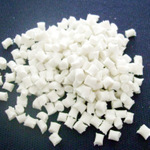What are the key points of processing PBT engineering plastics
Engineering plastics are better than general plastics in mechanical strength, impact resistance, heat resistance, hardness, corrosion resistance, wear resistance and aging resistance, so they are used as industrial parts or shell materials or as some mechanical parts instead of metals.
Polybutylene terephthalate PBT
Properties and applications: PBT is one of the toughest engineering thermoplastic materials. It is a semi crystalline material with excellent chemical stability, mechanical strength, electrical insulation characteristics and thermal stability. It has good stability under a variety of environmental conditions.
PBT has weak hygroscopic properties; It crystallizes rapidly, so it will be bent and deformed due to uneven cooling in the processing process. For materials with glass additives, the shortening rate in the process direction can be reduced, but it is basically no different from that in the straight direction of the process. The general shortening rate is between 1.5-2.8%, and the shortening rate of materials with 30% glass additives is between 0.3-1.6%; The melting point (225 ℃) and high temperature deformation temperature are lower than those of pet; The glass transition temperature is between 22 ℃ and 43 ℃.
Due to the high crystallization rate of PBT, its viscosity is very low, and the cycle time of plastic parts processing is generally low; It is commonly used to make household appliances, such as food processing blades, vacuum cleaner components, electric fans, hair monotone casings, coffee utensils, etc., electrical components, such as switches, motor casings, fuse boxes, computer keyboard keys, etc., radiator grids, body panels, wheel covers, door and window components in the automotive industry.

Key points of PBT processing
Monotonic treatment: this material is easy to hydrolyze at high temperature, so monotonic treatment before processing is very important. The monotonic condition in air is 120 ℃, 6-8 hours, maybe 150 ℃, 2-4 hours. It is necessary that the humidity be less than 0.03%. If the hygroscopic monotone is used, the claim condition is 150 ℃ for 2.5 hours.
2. Melting temperature: 225-275 ℃, claim temperature: 250 ℃.
Mold temperature: 40-60 ℃ for unreinforced materials. The cooling cavity of the mold should be well designed to reduce the bending of the plastic parts. The loss of heat must be fast and uniform. It is proposed that the diameter of the mold cooling cavity is 12mm.
3 injection pressure: medium (up to 1500bar).
4 injection speed: the injection speed should be as fast as possible (due to the rapid coagulation of PBT).
5 runner and gate: it is advocated to use circular runner to add pressure transmission (empirical formula: runner diameter = plastic thickness +1.5mm). Various types of gates can be used. Warm runner can also be used, but attention should be paid to prevent leakage and degradation of materials. The gate diameter should be between 0.8-1.0*t, where t is the thickness of the plastic part. In case of submerged gate, the minimum diameter is 0.75mm.
Polylithic 3001epg (+) halogen-free flame retardant PBT is a large halogen-free environment-friendly flame retardant plump polyester material with phosphorus and nitrogen as the main flame retardant elements. It plays a flame retardant role with the mechanism of carbon formation, swelling and other condensed phases. The flame retardant reaches UL94 V-0, and the hot wire test is satisfactory with gwfi960 ℃.
Halogen free flame retardant PBT 3001epg (+) has passed UL certification in the United States, and is satisfied with the requirements of RoHS, SVHC, halogen free, PAHs and other regulations. It has excellent characteristics such as good electrical performance, low smoke, and no corrosion to molds.
Article source: PBT engineering plastics http://www.wywantong.com/
-
04-13
PVC Engineering Plastics: how PVC plastic pipes are formed
The forming process of PVC plastic pipes should start from the raw materials of PVC plastic granules, which can be divided into soft PVC and hard PVC according to the added amount of stabilizer, plast
-
11-12
What is the filling property of Jiangmen engineering plastics
What is the filling property of Jiangmen engineering plasticsIn recent years, PC modified plastics have developed rapidly in China, and its industrial system is gradually established and improved. Th
-
10-08
Jiangmen Engineering Plastics: how to classify Jiangmen engineering plastics?
How to classify Jiangmen engineering plastics? 1. Classification by application characteristicsAccording to the different application characteristics of famous plastics, plastics are usually divided
-
08-30
Application scope of PBT engineering plastics
PBT engineering plastics are widely used in electronics, car industry, office machinery and other fields. In Japan and the developed countries in Europe, PBT engineering plastics are mainly used in t